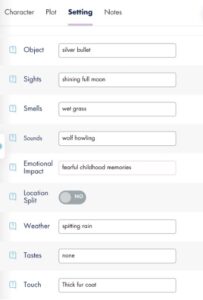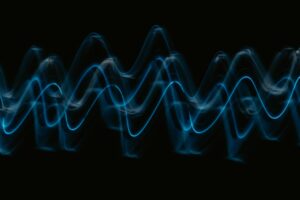
It’s important to describe sounds in fiction. When you describe sounds in fiction, it creates an immersive experience for your readers.
There are five senses: sight, sounds, taste, touch, and smell. In every second, we experience all five senses. The best way to replicate real life is to include all five senses. Today, we are going to look at how to incorporate sound in a story.
How to Write Sounds in Text
There are two ways you can write sounds in a story: you can show or you can tell.
When you show, you put the reader in the situation and allow them to experience the event first hand. When you tell, you explain verbally what is happening, meaning the reader takes a step back from the action. Both techniques can be useful in different situations.
Let’s take an example of showing rather than telling.
How to Write Sounds in a Story Example
There’s an urban legend you may have heard.
A girl lies in bed in the house of a distant acquaintance. An old, cavernous house. The tap in the bathroom next door won’t stop dripping. It’s creeping her out. She tries to sleep, but the noise is too irritating.
Drip. Drip. Drip.

The draughty bedroom makes her shiver. She’s too chilled to venture out and turn off the darn tap. Instead, she tries blocking it from her mind, thinking zen thoughts.
Drip. Drip. Drip.
No-one could sleep through this persistent annoyance. Why hasn’t anyone sorted the drip? But apart from the repeated plopping sound, the house is deathly silent, so it can’t be bothering the host.
Plop. Plop. Plop.
The noise grows louder, heaver, more insistent. It can’t just be all in her head. Someone must have forgotten to turn off the tap; it’s the only explanation. She’d better go switch it off herself, otherwise the bathroom will flood and the host will wonder why she didn’t do something about all that water.
Plop. Plop. Plop.
Pushing herself out of the rumpled, sweaty sheets, she pads barefoot out of the room, arms wrapped around herself. She’s sure she’ll be able to sleep once she’s stopped that infernal noise. She treads the corridor’s creaking floorboards, and turns the corner, telling herself it’s nothing. But her heart’s racing.

Plop-plop-plop.
Plop-plop-plop.
Plop-plop-plop.
She pushes open the bathroom door and screams.
A body hangs from the shower railing, crimson drops trickling from a thin gash in its throat, and–
You get the idea. We don’t need to go into the gory details. It’s not necessary–the blood and guts aren’t what make us afraid. It’s how we describe sounds that carries the threat, the fear, the tension.
When you describe sounds, the technique is one of the most critical sensory tools at a writer’s disposal, and has been ever since stories were first told around crackling fires.
Back before the days of paper and ink and computer software, stories were an aural experience, and the storyteller’s manner of telling critical to their success.
In modern days, the advent of moving cinematic pictures reiterated the importance of sound.
Who can forget the creaky jarring stabs of Psycho’s shower scene music, or the sweepingly epic soar of Titanic’s shimmering musical refrains? Modern readers are accustomed to stories being told with sound–whether those stories be cinematic, televisual, or in the form of audio books.
How to Write Onomatopoeia
An onomatopoeia is a word that sounds like the thing it is describing. For example, boom, pow, and oink. These words can be very useful when you are showing rather than telling a particular sound in your story.
How to Write Onomatopoeia Examples
Let’s look at a few examples on using onomatopoeia to show sound in a story.
- The wind whispered through the trees, rustling leaves like secrets.
- The witch’s cauldron bubbled and hissed, spitting out steam.
- With a swoosh, the hero’s sword sliced through the air, ready for battle.
- The toy train chugged along the tracks, tooting its cheerful whistle.
- With a pop, the champagne cork flew across the room, celebrating the joyous occasion.
- The bees buzzed around the flowers, a symphony of nature’s harmony.
- The cat meowed plaintively, seeking attention from its absent owner.
How to Describe Sounds to Make Stories More Immersive
There’s a useful–somewhat artificial–distinction between two ways writers describe sounds.
- First, think of story sounds
- Second, think of prose sounds
Story Sounds
These are the noises your point-of-view characters hear, like:
- Wolves howling
- The peal of bells
- Clattering of pans
- The shattering of glass.
Anthony Doerr begins All the Light We Cannot See by describing the thundering sound of approaching air-raid bombers, and in doing so immerses us into the perspective of the story’s blind protagonist.
Onomatopoeia
Onomatopoeia is a simple device to help readers ‘hear’ what your characters hear, and aid you when you describe sounds. It’s the use of words which read and are spoken the way they sound.
Examples include:
- Screech
- Click
- Hum
- Sizzle
- Or, as above, drip and plop, etc.
To describe sounds, exclamation marks or em-dashes may help format the noise. For example:
Bang!
I jumped out of my skin as a gunshot exploded overheard.
Or:
I walked down the road when–bang–a gunshot exploded overhead. I jumped out of my skin.
This formatting is more immersive for the reader than:
As I walked down the road I heard a loud bang, like a gunshot exploding overhead, and jumped out of my skin.
In the final example, the reader may not ‘hear’ the bang, thus missing its significance.

Think about how your characters respond to story sounds.
You can show us much about them through their reactions to, and perceptions of, their surroundings.
When a hardened gangster’s eyes well up upon hearing the hum of the operatic aria O Mio Bambino Caro–for it reminds him of his now-deceased mother, who adored Madame Butterfly—we see a new, intriguing side to him (as happened in an episode of Gotham).
How can Fictionary help you describe sounds?

If you use Fictionary software, you’ll automatically find yourself checking you describe sounds well throughout your scenes.
While you don’t need sounds in every scene, they will likely strengthen your key action and emotion scenes. Just don’t go overboard—especially on exclamation marks—or your reader will feel they’ve walked into a Batman comic (Crash! Bang! Wallop!).
Using Fictionary can also help you to ensure that you don’t over-rely on any particular noises and annoy your readers with them (e.g., excessive grunted replies or cackling laughs).
Prose sounds
These are the sounds—the music—of your prose. The rhythm and poetry of your writing contribute to your story’s voice.
To create voice, you may forgo standard grammar rules.
For example, in Autumn, Ali Smith uses abrupt, broken clauses alongside long, rambling sentences.
Sentence structure reflects the protagonist’s sense of disconnection with Brexit Britain. You can ‘hear’ her dislocation–from her world, her past, her thoughts, her previously-held identity–and her confused reaction, within the prose’s music.
To create a strong voice, familiarise yourself with rhetorical and poetic devices, such as:
- Onomatopoeia: described above
- Assonance: repeated use of vowel sounds (e.g., the mean eagle eased himself onto the eyrie)
- Alliteration: repeated use of consonants sounds (e.g., the sinuous serpent sashayed over savanna sands)
- Hyperbole/metaphor/simile: (e.g., the door groaned on its hinges like an old man suffering gout)
As the above examples demonstrate, when used injudiciously or excessively, these rhetorical devices can result in truly atrocious writing.

How to Write Noises in a Story
Can you see that when you describe sounds in fiction, you create a truly immersive experience for readers?
Pro Tip!
You’ve probably heard the advice to read your own writing out loud. (Argh! Cringe!) Don’t ignore this advice. Microsoft Word, Google Docs, Scrivener (and other apps and programs) can even do this for you, if you can’t reading aloud.
With the wave of audiobook sales sweeping over the publishing industry, you can’t afford to ignore the importance of sounds in and to your story.

